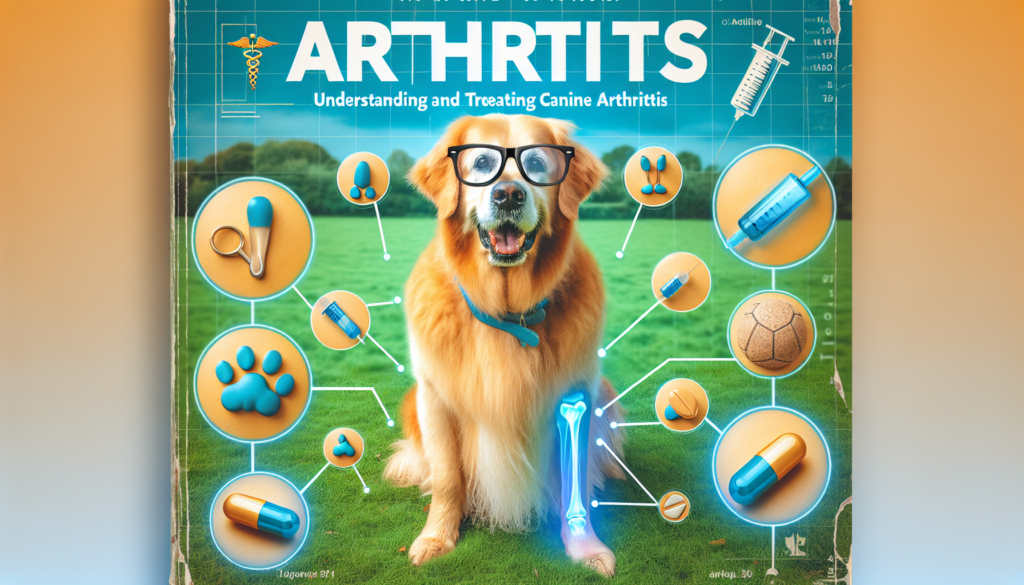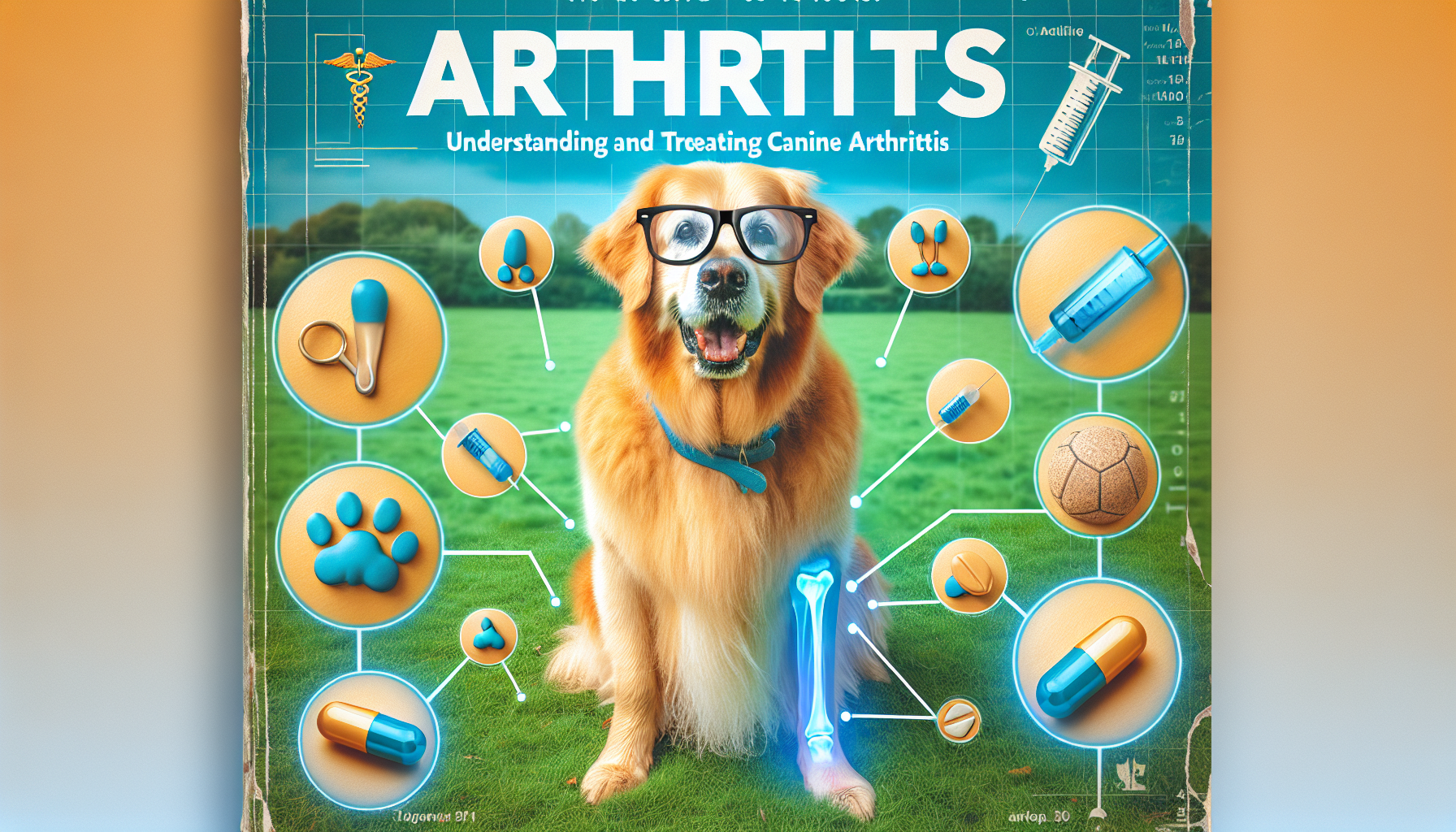You may not realize it, but your furry, four-legged friend could be silently suffering from arthritis. Canine arthritis is a common condition among dogs, causing pain and discomfort in their joints. In this article, we will explore the causes, symptoms, and treatment options for canine arthritis. By understanding this condition and learning how to effectively manage it, you can ensure that your beloved canine companion lives a comfortable and happy life. So, let’s dive into the world of canine arthritis and discover how we can help our furry friends find relief.
What is Canine Arthritis?
Canine arthritis refers to the inflammation and degeneration of the joints in dogs. It is a common condition that affects dogs of all ages, but it is more prevalent in older dogs. Arthritis is often caused by wear and tear on the joints over time, but it can also be the result of an injury or a genetic predisposition.
Definition
Canine arthritis is a chronic condition characterized by the inflammation of the joints. It can lead to pain, stiffness, and decreased mobility in affected dogs. Over time, the cartilage in the joints may wear down, leading to further degeneration and worsening symptoms.
Causes
There are several factors that can contribute to the development of canine arthritis. These include age, breed, genetics, obesity, joint injuries, and certain medical conditions. Large breed dogs and those with a history of joint problems are more prone to developing arthritis.
Symptoms
The symptoms of canine arthritis can vary depending on the severity of the condition. Common signs include limping, stiffness, difficulty standing or walking, reluctance to engage in physical activity, swelling or heat in the affected joints, and changes in behavior or mood. It is important to note that dogs may exhibit different symptoms, and it is always best to consult with a veterinarian for an accurate diagnosis.
Diagnosing Canine Arthritis
Early diagnosis of canine arthritis is essential for effective management and treatment. Veterinarians employ a variety of methods to diagnose arthritis in dogs.
Physical Examination
During a physical examination, the veterinarian will observe your dog’s gait, range of motion, and any signs of pain or discomfort. They may also palpate the joints to check for swelling or tenderness. A thorough examination can provide important clues about the presence of arthritis.
X-rays and Imaging
X-rays are commonly used to evaluate the condition of the joints. They can help detect any changes in the bone structure, such as joint narrowing or bone spurs. Other imaging techniques, such as ultrasound or magnetic resonance imaging (MRI), may also be used to provide a more detailed view of the joints.
Laboratory Tests
Laboratory tests, such as blood tests or joint fluid analysis, may be conducted to rule out other potential causes of joint inflammation and to assess overall health. These tests can help identify any underlying conditions or infections that may be contributing to the development of arthritis.

Treatment Options
Once a diagnosis of canine arthritis has been confirmed, there are various treatment options available to alleviate pain, improve mobility, and slow down the progression of the disease.
Medications
Medications are often a key component of arthritis treatment. Non-steroidal anti-inflammatory drugs (NSAIDs) are commonly prescribed to reduce inflammation and provide pain relief. Corticosteroids may also be used in some cases. Disease-modifying osteoarthritis drugs (DMOADs) are another option that can help slow down the progression of arthritis.
Physical Therapy
Physical therapy can be highly beneficial for dogs with arthritis. Range of motion exercises, massage, and joint mobilization techniques can help improve flexibility and decrease stiffness. Hydrotherapy, such as swimming, can also provide non-weight-bearing exercise and promote muscle strength and joint mobility. Cold laser therapy is a non-invasive treatment that uses low-level lasers to reduce inflammation and stimulate healing.
Weight Management
Maintaining a healthy weight is crucial for managing arthritis in dogs. Excess weight puts additional stress on the joints, exacerbating pain and limiting mobility. A combination of diet modification and regular exercise can help dogs achieve and maintain a healthy weight.
Nutritional Supplements
Certain nutritional supplements can support joint health and reduce inflammation in dogs with arthritis. Glucosamine and chondroitin are commonly used to promote cartilage health and improve joint function. Omega-3 fatty acids have anti-inflammatory properties and can help reduce joint pain. Turmeric and boswellia are natural supplements that have shown promising results in managing arthritis symptoms.
Surgery
In severe cases of canine arthritis, surgery may be necessary. Surgical procedures, such as joint replacement or joint fusion, can help alleviate pain and improve joint function. These procedures are typically considered when conservative treatments have failed to provide relief.
Medications for Canine Arthritis
Several medications can be prescribed to manage pain and reduce inflammation in dogs with arthritis.
Non-Steroidal Anti-Inflammatory Drugs (NSAIDs)
NSAIDs are commonly prescribed to provide pain relief and reduce inflammation in dogs with arthritis. They work by inhibiting the production of prostaglandins, which play a role in the inflammatory response. NSAIDs should only be used under the guidance of a veterinarian, as they can have potential side effects.
Corticosteroids
Corticosteroids, such as prednisone, can be prescribed for dogs with severe arthritis or acute flare-ups. They have powerful anti-inflammatory effects and can provide rapid relief. However, long-term use of corticosteroids can have side effects, such as immune suppression and increased susceptibility to infections.
Disease-Modifying Osteoarthritis Drugs (DMOADs)
DMOADs are a newer class of medications that can help slow down the progression of arthritis and protect the cartilage in the joints. These drugs, such as polysulfated glycosaminoglycan (PSGAG), provide long-term benefits and are often used in conjunction with other treatments.

Physical Therapy for Canine Arthritis
Physical therapy is a valuable treatment modality for dogs with arthritis, as it can improve mobility and alleviate pain.
Range of Motion Exercises
Range of motion exercises help maintain flexibility and prevent joint stiffness. These exercises involve gently moving the joints through their full range of motion to promote joint health and maintain joint function.
Massage and Joint Mobilization
Massage and joint mobilization techniques can help relieve muscle tension, reduce pain, and increase blood circulation to the affected joints. These techniques are commonly used alongside other treatment modalities to improve overall comfort and mobility.
Hydrotherapy
Hydrotherapy, such as swimming or walking on an underwater treadmill, provides a low-impact form of exercise that reduces stress on the joints. The buoyancy of water helps support the dog’s weight while allowing them to move their joints freely.
Cold Laser Therapy
Cold laser therapy, also known as low-level laser therapy, uses low-intensity lasers to stimulate the cells in the joints and reduce inflammation. This non-invasive treatment can improve joint mobility and alleviate pain in dogs with arthritis.
Weight Management for Canine Arthritis
Maintaining a healthy weight is essential for dogs with arthritis to reduce stress on their joints and improve overall mobility.
Importance of Maintaining Healthy Weight
Excess weight puts additional strain on the joints, exacerbating arthritis symptoms and increasing the likelihood of further joint damage. By maintaining a healthy weight, dogs can experience reduced pain and improved quality of life.
Recommended Diet for Arthritic Dogs
Arthritic dogs should be fed a balanced and nutritious diet that supports joint health. High-quality dog food formulated for joint support, which contains ingredients like glucosamine and chondroitin, can provide the necessary nutrients for cartilage repair and overall joint function.
Exercise Guidelines
Exercise is crucial for dogs with arthritis, but it should be done in a controlled and low-impact manner. Short, frequent walks or gentle play sessions can help maintain muscle tone and joint flexibility without causing excessive strain. It is important to consult with a veterinarian to determine the appropriate exercise regimen for each individual dog.
Nutritional Supplements for Canine Arthritis
Certain nutritional supplements can help improve joint health and alleviate arthritis symptoms in dogs.
Glucosamine and Chondroitin
Glucosamine and chondroitin are natural compounds found in healthy cartilage. These supplements can promote cartilage repair and provide anti-inflammatory effects, reducing pain and improving joint function in arthritic dogs.
Omega-3 Fatty Acids
Omega-3 fatty acids, commonly found in fish oil, have anti-inflammatory properties that can help reduce joint inflammation and pain. Adding omega-3 fatty acid supplements to a dog’s diet can provide additional support for their joints.
Turmeric and Boswellia
Turmeric and boswellia are natural supplements that have anti-inflammatory properties. They can help reduce pain and inflammation in dogs with arthritis. These supplements are often used in conjunction with other treatments for optimal results.
Alternative and Complementary Therapies
In addition to conventional treatments, alternative and complementary therapies can be beneficial in managing arthritis symptoms in dogs.
Acupuncture
Acupuncture involves the insertion of thin needles into specific points on the body to stimulate the release of endorphins and promote pain relief. It can help alleviate arthritis pain and improve overall well-being in dogs.
Chiropractic Care
Chiropractic care involves gentle adjustments to the spine and joints to improve joint mobility and reduce pain. It can be used as a complementary therapy to conventional treatments for dogs with arthritis.
Herbal Medicine
Herbal medicine uses natural herbs and plant extracts to alleviate pain and reduce inflammation. There are various herbal remedies available that can provide support for dogs with arthritis. It is important to consult with a veterinarian or a trained herbalist before using any herbal remedies.
Massage and Acupressure
Massage and acupressure techniques can help reduce muscle tension, alleviate pain, and improve blood circulation in dogs with arthritis. These therapies can be performed by a professional or learned by pet owners for regular at-home care.
Managing Arthritis in Senior Dogs
Senior dogs require special considerations when it comes to managing arthritis and providing them with a comfortable and supportive environment.
Special Considerations for Older Dogs
Senior dogs may have additional health issues that need to be taken into account when managing arthritis. Conditions such as heart disease or kidney problems may impact the choice of medications or treatment options.
Adapting the Environment
Modifying the home environment to accommodate the needs of a senior dog with arthritis is essential. Providing non-slip surfaces, ramps or steps for easier access to elevated surfaces, and comfortable bedding can make a significant difference in their daily life.
Supportive Equipment
Using supportive equipment, such as orthopedic beds or joint braces, can help relieve joint pressure and provide additional support for senior dogs. These aids can improve their overall comfort and mobility.
Prevention and Home Care
Prevention and home care play a crucial role in managing and minimizing the development of canine arthritis.
Regular Exercise
Regular exercise, tailored to the individual dog’s needs and limitations, is important to keep the joints mobile and maintain muscle strength. It is crucial to strike a balance between activity and rest to avoid overexertion or causing unnecessary stress on the joints.
Joint-Friendly Activities
Engaging in joint-friendly activities, such as swimming or walking on soft surfaces, can help minimize stress on the joints. Avoiding high-impact activities, such as jumping or rough play, can help prevent joint injuries and minimize the risk of developing arthritis.
Comfortable Sleeping Surfaces
Providing comfortable and supportive sleeping surfaces, such as orthopedic beds or memory foam mattresses, can alleviate pressure on the joints and ensure a restful sleep for dogs with arthritis.
Supervision and Safety Measures
Supervising dogs with arthritis and implementing safety measures, such as installing ramps or using mobility aids, can help prevent falls or further joint injuries. Regularly monitoring their condition and seeking veterinary care as needed is essential for their overall well-being.
In conclusion, canine arthritis is a common condition that can significantly impact a dog’s quality of life. Early diagnosis and a comprehensive treatment plan are essential for managing arthritis and providing relief to affected dogs. With the right combination of medications, physical therapy, weight management, and supportive care, dogs with arthritis can experience improved mobility and reduced pain. By understanding and addressing the needs of arthritic dogs, we can ensure they live happy and comfortable lives.

